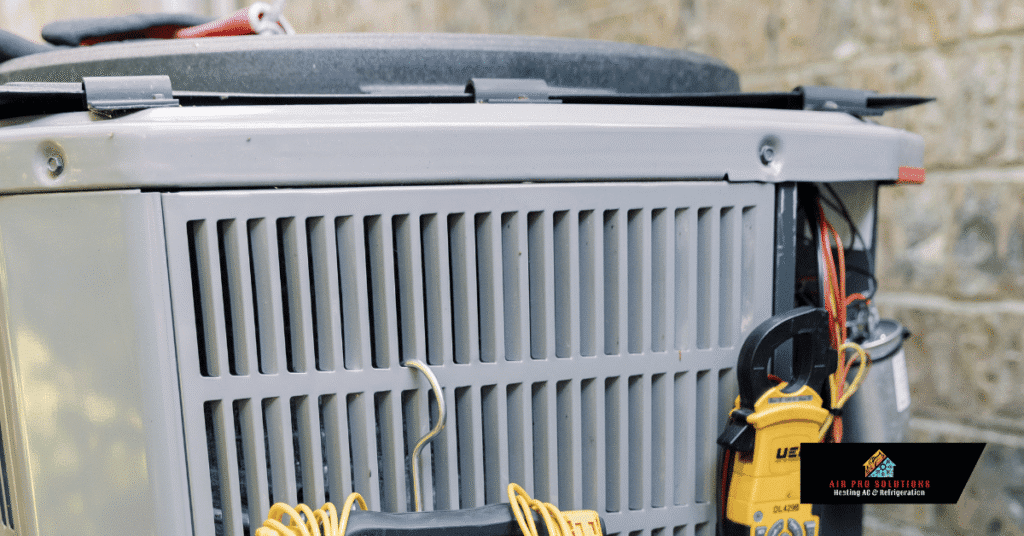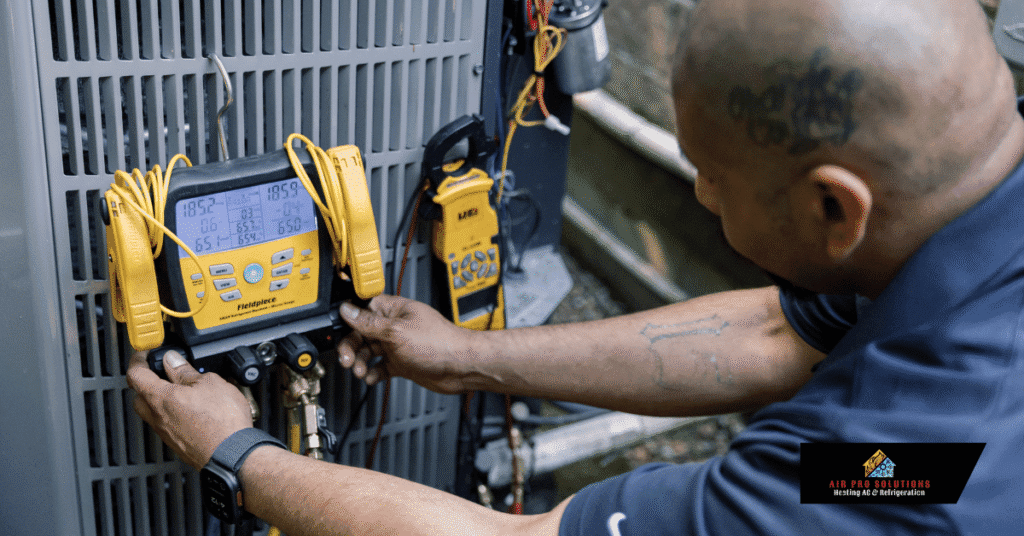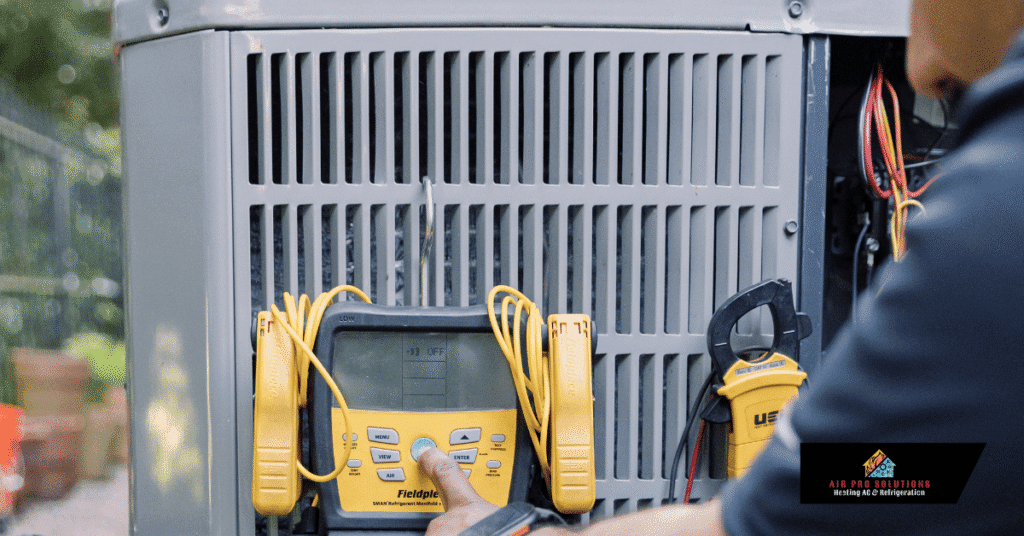Finding the best air conditioner for your home isn’t just about brand names or fancy features. One of the most important things to look at is the ac SEER rating, which stands for Seasonal Energy Efficiency Ratio. This number tells you how energy-efficient your cooling system will be.
If you live in Auburn or the surrounding areas, knowing what an air conditioner SEER rating means can help you save money on your energy bills while keeping your home comfortable.
At Air Pro Solutions, we help homeowners choose the right AC unit, and understanding SEER ratings is the first step in making a smart investment.
What Does SEER Rating Mean?
SEER stands for Seasonal Energy Efficiency Ratio and is the official energy efficiency rating used by the U.S. Department of Energy. It measures how efficiently an air conditioner or heat pump converts electricity into cooling over an entire season.
A higher SEER rating means the air conditioner will use less energy to cool your home.
Think of it like miles per gallon (MPG) in a car. Just as higher MPG means better fuel efficiency, a higher SEER means better energy savings.
For example, an AC unit with a SEER rating of 18 will use less energy to cool your home compared to an older air conditioner with a SEER rating of 13.
Why SEER Rating Matters for Homeowners
For Auburn homeowners, summer months can put real stress on central air systems. Choosing a system with a good SEER rating pays off in multiple ways:
- Lower energy bills – less power used per cooling cycle.
- Consistent comfort – higher SEER air conditioning units often cool more evenly.
- Environmental benefits – energy-efficient air conditioners reduce greenhouse gas emissions.
- Long-term value – investing in efficiency saves money across the lifespan of your AC unit.
What Is a Good SEER Rating for AC Units?
The U.S. Department of Energy sets minimum SEER rating requirements. Currently:
- Northern states require a minimum SEER rating of 14.
- Southern states require a minimum SEER rating of 15.
For Washington homeowners, systems with a SEER rating between 15–18 offer a good balance of cost and efficiency.
Premium air conditioners and high SEER AC units can reach ratings of 20 or higher, often seen in ductless mini splits or advanced central air conditioners.

SEER Rating Comparison Table
| SEER Rating Range | Efficiency Level | Typical Energy Savings | Best For |
| 13 – 15 | Standard | Baseline savings | Budget-conscious homes |
| 16 – 18 | High | 15–20% less energy use | Balance of cost & savings |
| 19 – 21 | Very High | 25–30% less energy use | Larger homes, frequent cooling |
| 22+ | Premium | 35%+ energy savings | Long-term homeowners, ductless installs |
SEER Ratings vs Initial Cost – Finding the Balance
Homeowners often ask if a higher SEER rating is worth the upfront cost. Here’s the trade-off:
- Higher upfront cost – systems with higher SEER ratings are more expensive to buy and install.
- Lower energy bills – high-efficiency air conditioners use less energy, saving money monthly.
- ROI – depending on how often you use your AC unit, energy savings can cover the initial price in a few years.
If you plan to stay in your Auburn home for many years, choosing a higher SEER system is usually the smarter move.
SEER Ratings and Ductless Mini Splits
Ductless mini split systems are among the most efficient cooling options. Many models feature SEER ratings of 20 or higher.
Benefits of ductless systems:
- No ductwork required – ideal for older homes.
- Zoned comfort – allows separate control in different rooms.
- High efficiency – often outperform central air conditioners.
At Air Pro Solutions, we specialize in ductless mini split installation, ensuring maximum efficiency and comfort.
Common Myths About Ac SEER Ratings
Myth 1: Higher SEER means more cooling power.
SEER is about efficiency, not raw output. A 14 SEER and 20 SEER unit can cool the same space, but the high SEER uses less energy.
Myth 2: All high-SEER units are the same.
Features like variable-speed motors, smart thermostats, and humidity controls make a difference.
Myth 3: SEER is the only factor.
Proper installation, ductwork, cleaning, and repair are equally important to overall air conditioner efficiency.

How to Choose the Right SEER Rating for Your Home
Every home has unique needs. Consider:
- Home size and insulation – poorly insulated or large homes may need a higher SEER rating.
- Budget – balance upfront cost with monthly savings.
- Energy bills – if lowering energy costs is a priority, a higher SEER makes sense.
- Ownership plans – moving soon? A mid-range unit with a SEER rating of 15–16 may be enough.
Why Professional Installation Matters
Even the best air conditioner with a high SEER rating won’t perform efficiently if not installed correctly.
Professional installation ensures:
- Proper sizing of the unit.
- Clean and sealed ductwork.
- Accurate refrigerant levels and airflow.
At Air Pro Solutions, our expert technicians handle installation, repair, and cleaning to maximize your system’s energy efficiency rating.
AC Maintenance and SEER Performance
Your air conditioner’s efficiency declines without proper care. To protect your unit’s SEER rating:
- Replace filters regularly.
- Schedule professional cleaning and repair.
- Inspect refrigerant levels.
- Clean coils and perform annual tune-ups.
Air Pro Solutions provides full maintenance services in Auburn to keep your central air conditioner or ductless system operating at peak efficiency.

Conclusion: Making the Smart Choice
Choosing the best air conditioner for your home means understanding SEER ratings. A higher SEER rating delivers energy savings, lower energy bills, and consistent comfort. But the real results depend on quality installation, cleaning, and repair.
If you’re shopping for a new air conditioner, or want more information about the air conditioner’s SEER rating, Air Pro Solutions can help. We guide you through options, provide expert installation, and keep your system efficient for years to come.















